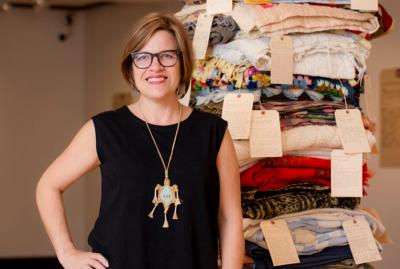Marie Watt: Rockwell Museum

Blanket Stories: Western Door, Salt Sacks and Three Sisters
a solo exhibition by Marie Watt at the Rockwell Museum in Corning, NY
On view: May 5 – September 5, 2017
Opening Reception: Thursday, May 4, 2017
This summer at The Rockwell, explore the histories and memories tied to humble household objects – blankets. How can a simple blanket ignite conversations? What memories are held in the folds? How can fabric tie an individual to the community at large, or to a place and time?
Blanket Stories: Western Door, Salt Sacks, and Three Sisters is a collaboration between artist Marie Watt, The Rockwell Museum, and the greater Corning, NY, community, as well as an ongoing series in the artist’s practice. Watt – who draws upon biography, history, Iroquois teachings, and Seneca proto-feminism – was invited to gather stories that tether people to place and community.
Each story is represented by a textile in a sculptural tower. The textiles were contributed in response to a call for blankets and their stories from the community including local residents, the greater Finger Lakes region, and friends of The Rockwell. While each blanket in this column represents one person’s story, it also serves as a marker for the collective memory of a larger extended family. Each story communicates the universal nature of our shared human condition and has the potential to unite us.
Marie Watt, Artist Statement
I describe myself as a multidisciplinary artist who draws from biography, history, Seneca proto-feminism and Iroquois teachings. Through my work, I gather stories that tether me to place and community.
I seek to ignite conversations between multi-generational participants as a means of revealing how we are connected and related. I consider this an Indigenous approach to knowledge sharing, organizing, and learning. Collaboration is an active agent in this work, not simply a means to an end or “process”.
Blankets are personal to me. In my family and in my tribe— I am Seneca—we give blankets away to honor people for being witnesses to important life events (births and comings-of-age, graduations and marriages, namings and honorings). I also noticed early on that blankets are markers for memory and story.
With this in mind, I have collaborated with The Rockwell Museum and its Western New York community to create this sculpture. An open invitation was sent, and self-selected participants have contributed a blanket (or its proxy) and its blanket story, and in exchange were given a silk screen print for their contribution.
The invitation to collaborate with this Western New York community has special meaning to me. My mom grew up in a big family on the Cattauragus Reservation in Gowanda, NY, and my grandparents’ first language was Seneca. While I didn’t grow up here, it is a place I return to annually. The Rockwell Museum and Corning, New York, are part of an expansive territory that was once the homeland of Iroquois people, and more specifically the Seneca. The title for this sculpture— Blanket Stories: Western Door, Salt Sacks, and Three Sisters— reflects further on these relationships and the blanket stories within.
Western Door
The Seneca Nation of Indians is one of six tribes that form The Iroquois Confederacy or Haudenosaunee (People of the Longhouse). Historically, the western-most tribe of the Six Nations, the Seneca, are known as the Keepers of the Western Door. In the context of Corning, New York and The Rockwell Museum, Western Door acknowledges the long standing presence of Seneca people in Western New York.
Salt Sacks
I am struck by how a humble blanket, made from salt sacks, tells a story about human resourcefulness, a family heirloom, and a regional industry. Salt refineries were a significant part of Western New York’s economy from the late 18th Century to the early 20th Century. The blanket story from Helen Sawyer simply reads:
“Made by Cecelia (Markowicz) Van Gorder in 1920 from salt bags from the Tecumsen Salt Co. Silver Springs, NY. When times were tough flour sacks, feed sacks and salt sacks were used to such things as clothes and blankets.”
I personally associate this salt sack blanket with my mom’s stories of having play clothes made out of re-purposed cloth flour sacks. This salt sack blanket is indicative of the abundance of quilts, and their stories, collected in this project. They represent the labor— enterprising, creative, and social— of women in Western New York and their immigrant families.
Three Sisters
Three sisters refers to the Iroquois staple foods— Corn, Beans, and Squash— that offer sustenance, nutritional and spiritual, to our community. Traditionally, they are planted in a way that Corn’s long stalk creates a support for Beans to climb. Beans contribute nitrogen to the soil. Squash has a broad leaf covering that protects their roots and keeps the soil moist. When grown together, they thrive; this is also a metaphor for community and how we are inter-connected and related. In this sculpture I have incorporated three tiers of jingles, traditionally used in pow-wow regalia, to reference the Three Sisters.